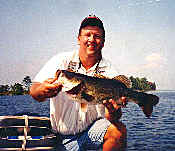Lakecaster Online Archives – October, 1999
As the dog days of summer start winding down, I always look forward to the first few cold fronts of the year. These cold fronts cause a lot of positive things to happen. For one the air temperature and water temperature begin a downward trend. After the heat that we experienced this summer, this is going to be a welcome relief for the fishermen and the fish. These cold fronts usually mean rain and the Big Pond should start getting back closer to normal pool elevation.
One of the benefits that I enjoy is that those cooler temperatures get a lot of people to thinkin’ ’bout 4-wheelers, and guns and dove birds and deer camp and that means a little more elbow room out on Big Sam. But best of all is that the reduced water temperature, the increased cloud cover and the rise in water level will put those bass on the prowl and make ’em hungry. And anytime that the bass are scattered and feeding, my hand reaches for my Rat-L-Trap rod.
A lot of people think that a Rat-L-Trap is an idiot bait, that anyone can just throw it out and reel it in and catch fish. And many times, especially when the fish are schooling, it is just that easy. But for those other times, I’m going to give you a few tips that have worked for me in the past.
First, I suppose, would be when to fish a Rat-L-Trap this time of year. Well, early and late are always good, but some of the best action is going to be on the cloudy, overcast, rainy days. These are the kind of days when the bass are really roaming and feeding. They are fairly easy to catch when you find one but the problem is that they are scattered and moving around in search of food. This where the rattles in a Rat-L-Trap come in handy. The bass can hear those rattles from a long distance and are attracted to this clicking/rattling noise. Then, when they get closer, they can feel the vibration of the bait in the water and will home in on this to make the kill.
One of the best places to make this work for you is on a large, main lake moss bed like Needmore Point or Farmers Point or Buck Bay. These type areas hold fish all year long and they won’t be getting pounded quite as hard now that we have lost some of our fellow outdoorsmen to the woods. Anytime that you can find moss with 3′-10′ of water over the top of it, you have found prime Rat-L-Trap water. Bass can be caught at these type locations without the cloud cover, but the wind has to be blowing. There is something about bright sunshine and no wind that really slows down the Rat-L-Trap bite.
What about bait color and size? There is definitely something positive about showing the bass something different, so I throw a lot of different colors and sometimes change the size of my bait. Pumpkinseed w/ green flake, firetiger, chartreuse w/ blue back, chrome w/ blue back, and chrome w/ black back are just some of the colors that I catch fish on all the time. Longear sunfish is a new color that was introduced this year that has gotten to be one of my new favorites.
I usually start out throwing one of the new one ounce ‘Traps because it just seems to produce better fish for me. If the action with this one is slower than what I would like, then I’ll step down to the 3/4 ounce, 1/2 ounce and sometimes even a 1/4 ounce model.
One trick that you might try for finicky schooling fish that won’t hit you’re other offerings is to try a 1/8 ounce Tiny Trap. Sometimes those schooling bass are feeding on small shad and they just won’t hit anything any bigger.
Also, I have been fishing with some new Trap type baits made by Berkley called Frenzy Rattl’r’s. They come in 1/2 oz. and 1/4 oz. models and Bluegill and Chrome Blue Back are my favorite colors. They have a little bit different wiggle and put out a little bit different sound from from a Rat L Trap, and sometimes those little differences can be big differences to the fish. Try ’em, I think you’ll like ’em.
Here’s a trick to keep you from breaking your line. Many times a ‘Trap fish will bury itself in the moss no matter how hard you try to keep their head up. The best thing to do when this happens is to get directly over the top of the fish, put your rod down, get the line in your hands and pull straight up. I’m not sure why, but this really works. Another thing to help you keep bass on the line is to stick your rod as deep as you can in the water and reel as fast as you can, whenever see your line start coming to the top of the water. When a bass jumps with a Rat-L-Trap in his mouth, he is difficult to keep hooked. But, if you’ll do the rod dippin’, hard reelin’ trick then you can prevent some of those jumps and keep more fish on the hook.
Why bother? Why not just fish a Texas rigged plastic worm or a wacky worm? The reason is that a crankbait can be presented to a much larger number of fish in the course of a day, because we fish it so much faster. A worm is a very slow way to fish and that makes it very slow way to find fish. This is why the Rat-L-Trap is one of the best search baits or fish-finding baits available. And every tournament pro will tell you, “You can’t catch ’em if you can’t find ’em.”
Let’s briefly touch on equipment. For line, I prefer fresh, premium quality 14-20 pound test green monofilament. If I am catching my fish above or just outside of the moss. I like to use a 6’6″ or 7’0″ medium Fenwick fiberglass crankbait rod (model FT66MH). I feel that a rod of this type (crankbait rod) is very helpful to successful Rat-L-Trap fishing because these rods are constructed with 100% fiberglass, as opposed to almost pure graphite, like the worm and jig rods. This increased fiberglass content seems to decrease the sensitivity just enough to force us to let the bass “have” the bait long enough to get hooked. All theory aside, I just know that I hook and land more Rat-L-Trap and crankbait bass on a rod of this type than a pure graphite rod. Also, I use like to use a quality, high-speed baitcasting reel with a thumb bar release like an Abu Garcia 4600C3 or the new ultra-high speed 4600C4.
I sincerely hope that at least some of the information that I have provided was enlightening or maybe entertaining but most of all helpful and educational. If you would like some first hand instruction on black bass fishing on Lake Livingston or Sam Rayburn, I guide full time on both of these lakes and can be reached at (409) 327-1932. Until next time, catch all you can and release all you catch. Good luck, be safe out there and may God bless.
Sponsored by: Ranger Boats, Motorguide, Pro-Kon-Trol, Lowrance Electronics, Abu Garcia, Fenwick, Berkley, Trojan Batteries, Turbo Props, Dual Pro Battery Chargers, Bill Lewis Lures, Castaic Soft Baits, VMC Hooks and Ocean Waves Sunglasses
Copyright © 1999 – 2005 by Lakecaster Publications, Onalaska, Tx. All rights reserved. Usage rights granted to Toledo-Bend.Com





